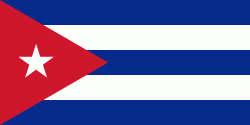Las Tunas (Las Tunas)
The city of Las Tunas is located in along the Carretera Central (highway), between the cities of Camagüey, Holguín and Bayamo.
In 1943 the municipality was divided into the barrios of Primero, Segundo, Antonio Machado, Arenas, Caisimú, Cauto del Paso, Cuaba, Curana, Dumañuecos, Ojo de Agua, Oriente, Palmarito, Playuelas and San José de la Plata. The city is currently divided into the repartos (wards) of Primero (city centre), Segundo, La Victoria, Aguilera, Santo Domingo, Pena, La Loma, Aurora, Velázquez, Sosa, Casa Piedra, Israel Santos, Buena Vista, Alturas de Buena Vista, Propulsión, Aeropuerto and Reparto Militar.
Map - Las Tunas (Las Tunas)
Map
Country - Cuba
 |
 |
| Flag of Cuba | |
The territory that is now Cuba was inhabited by the Ciboney people from the 4th millennium BC with the Guanahatabey and Taíno peoples until Spanish colonization in the 15th century. From the 15th century, it was a colony of Spain, and slavery was abolished in 1886, remaining a Spanish colony until the Spanish–American War of 1898, when Cuba was occupied by the United States and gained independence in 1902. In 1940, Cuba implemented a new constitution, but mounting political unrest culminated in a coup in 1952 and the subsequent dictatorship of Fulgencio Batista, which was later overthrown in January 1959 by the 26th of July Movement during the Cuban Revolution, which afterwards established communist rule under the leadership of Fidel Castro. The country was a point of contention during the Cold War between the Soviet Union and the United States, and a nuclear war nearly broke out during the Cuban Missile Crisis of 1962. Following the collapse of the Soviet Union, Cuba faced a severe economic downturn in the 1990s, known as the Special Period. In 2008, Fidel Castro resigned after 49 years of leadership of Cuba and was replaced by his brother Raúl Castro.
Currency / Language
| ISO | Currency | Symbol | Significant figures |
|---|---|---|---|
| CUC | Cuban convertible peso | $ | 2 |
| CUP | Cuban peso | $ | 2 |
| ISO | Language |
|---|---|
| ES | Spanish language |















